|
High Power Output Stages
The obvious difference between PA equipment and an ordinary AF amplifier lies in the output stage, for much greater output is naturally needed. For public address purposes an output of some 30 Watts is usually considered the minimum, and there are two entirely distinct methods in common use of obtaining this. One is to employ a large output stage, the other to use a number of small ones.
The latter course is widely adopted and the equipment consists of a number of quite separate amplifiers, each having an output of some 12 Watts. An output of this order is easily obtained from a pair of PX25, PP5/400 DO24, or similar valves operated in push-pull. The amplifiers are arranged so that the inputs and outputs can be paralleled and so feed a group of loud speakers, or each amplifier call feed only one or two speakers.
The advantage of this arrangement is that should a defect occur in any amplifier the whole equipment is not thrown out of action, for the remaining amplifiers can carry on at somewhat reduced power while the defective one is being put right.
Moreover, it makes a flexible installation, which is particularly suited to PA contractors who have to make provision for widely varying conditions. One day's work, for instance, may be done satisfactorily with a modest output of 20 Watts or so, whereas at another time four or five times this figure may be necessary.
For permanent installations, however, the single channel type of equipment is more often adopted, and it is then necessary to include a large output stage, the minimum normally required being some 30 Watts. It is quite possible to secure an output of 30 Watts from a pair of valves operated in push-pull and one possibility is to use PX25A valves in the low-loading circuit. An HT supply of no more than 500 Volts is necessary and the circuit diagram is of conventional type, the unusually large output being obtained not with the aid of some freak circuit but by the adoption of special operating conditions for the valves. Still greater output can be secured from this system by using large valves and with two DA3O valves no fewer than 44 Watts can be secured with an HT supply of 500 Volts.
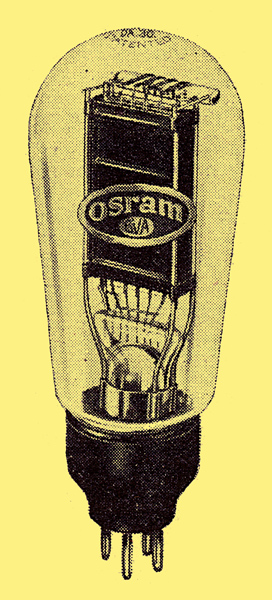
An Osram DA30
Large output valves of this type are not always well adapted to the positive drive of the Class B system, for it is often dangerous to valve life to permit grid current. When using the DA30 valves it is necessary to connect a diode across the input circuit in order to prevent a dangerously high positive voltage being applied to the grid during a momentary overload.
The low-loading system demands suitable types of valve and is of little benefit with some specimens. There are many cases, therefore, where ordinary operating conditions are adopted and large valves employed. A single valve of the DA60 MZ05-60, 660T, K450/50 class will give out some 10 Watts, so that a pair in push-pull might reasonably be expected to deliver an output of some 25 Watts or more. Even larger valves are available, and it is possible to obtain 30 Watts from a single valve such as the PP100/1000 with an anode dissipation of 100 Watts; the HT supply is then usually about 1,000 Volts however.
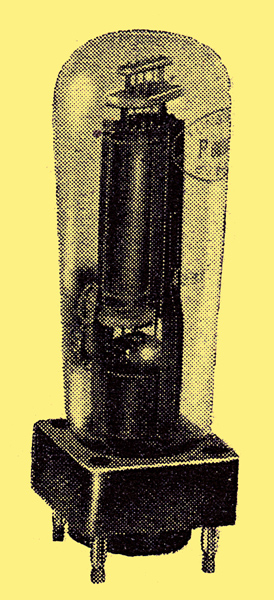 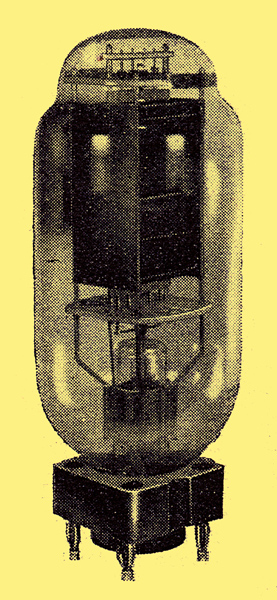 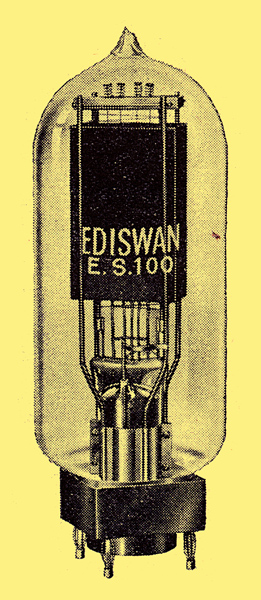
The Tungsram P60/500 & P100/1000 and Ediswan ES100
In order to avoid such a high voltage it is more usual to employ push-pull, and to reduce to a minimum the power supply use is often made of Class B systems in spite of the greater difficulty of obtaining distortion less reproduction. By adopting this system surprisingly large, outputs can be secured from small valves.
Two of the American 6L6 valves run in Class AB, that is, a condition approaching quiescent push-pull will give an output of 34 Watts with only 2 per cent distortion and with an HT supply of 400 Volts. The anode current is necessarily fluctuating, but only between the limits of 100 mA and 152 mA. Still greater output can be secured by operating them in Class B and no fewer than 60 Watts can be secured still with only 400 Volts HT. The peak current consumption, however, is 250 mA, and the fact that grid current is permitted necessitates very careful design of the driver stage if distortion is to be avoided.
Larger valves are often used in Class B, however, and if suitable types are selected the necessary positive drive is not detrimental to valve life. For large output two DA100 valves may be used at 1,000 Volts anode potential, and no fewer than 200 Watts output obtained for 4 per cent harmonic distortion. The anode current consumption at full load is 300 mA, and 250 Volts peak input is needed. This must be obtained from a pair of push-pull PX25 valves in the driver stage with cathode coupling, and these in turn require a pair of push-pull ML4 type valves to provide their input.
Rectifiers
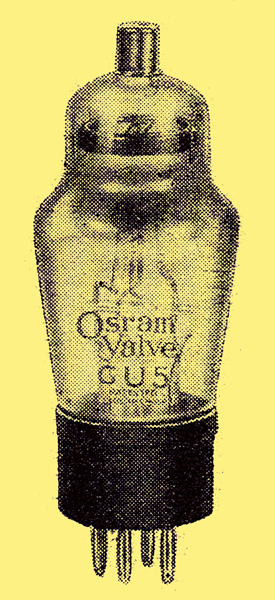
An Osram GU5
When large output stages of this type are needed the mains equipment must be carefully designed and a mercury rectifier such as the GU5 is adopted. This valve is capable of an output of 500 mA at 1,000 Volts, but as it is a half-wave rectifier two are usually employed to give full-wave rectification.
The Input Stage
The difficulties of PA equipment are by no means confined to the output stage, however, for some cases the input stage can be even more troublesome. When an insensitive type of microphone is employed such as the ribbon or condenser types, a very high degree of amplification is necessary and valve noise in the first stage becomes very important. Several valve makers have introduced special types of valve for such cases, and the MH40, A537 and V312 are examples of these. Such valves cost considerably more than ordinary types and have similar characteristics. They are characterised, however, by a special construction which renders them much less microphonic and gives them a lower inherent noise level.
Where sensitive microphones of the carbon type are adopted, of course, no difficulties arise in the input stage, and it is for this reason that they are so widely used in spite of their inferior characteristics from a quality point of view.
|